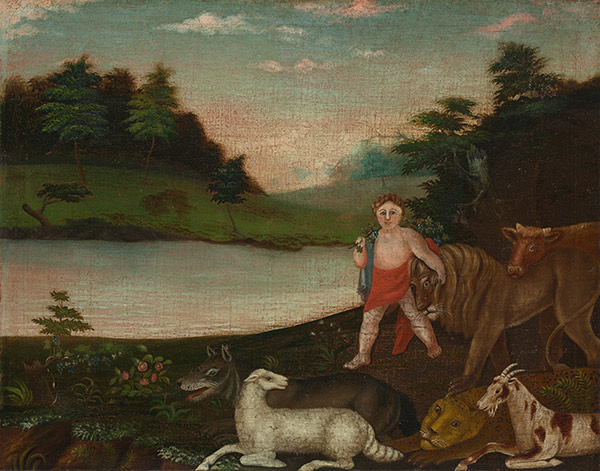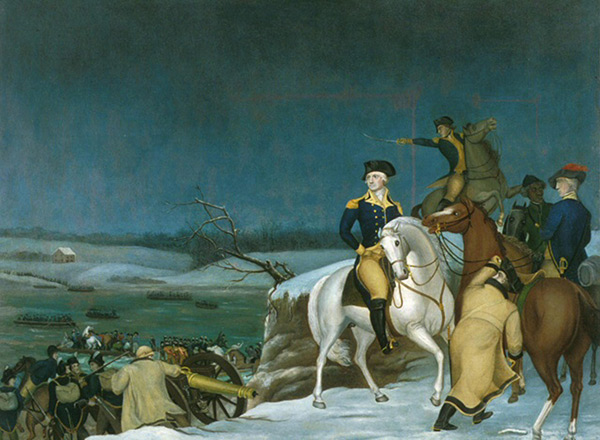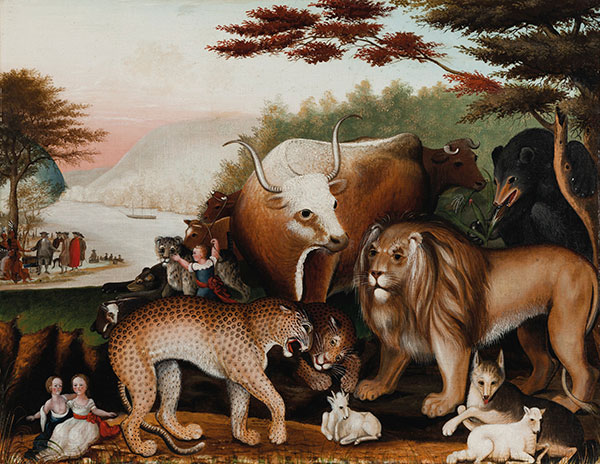Subtotal: $
Checkout
Edward Hicks: Pacifist Patriot
An early American artist reconciled his Quaker convictions with the promising ideals of a new nation.
By Cody Cook
February 11, 2025
Edward Hicks was an artist, a Quaker, a pacifist, and a patriot. This might seem an unlikely combination. While some artists are patriotic, the creative personality is usually opposed to the groupthink that marks patriotic fervor. And can a pacifist be a true patriot? During the American Revolution, you were expected to be either loyal to Britain or a rebel who supported the revolution. The Quakers, who were opposed to war on principle, were considered by many to be unacceptably neutral. In this milieu, Hicks was a perplexing contradiction. How was he able to reconcile his pacifist convictions with his commitment to the foundational American ideals of freedom and liberty, which others had established through revolution and violence?
Hicks was born in 1780 in Bucks County, Pennsylvania – four years after the Declaration of Independence was signed and seven years before the United States Constitution was written. After the death of his mother in 1781, he was raised by a Quaker couple. At the age of thirteen, he became an apprentice coach maker. In addition to learning how to paint, he also discovered gambling and drinking early on; he later admitted to frequenting “tippling houses, gambling tables,” and “houses of ill-fame” during his youth.
When he was twenty-three, he put carousing behind him and joined the Quaker church. Throughout his twenties, Hicks dabbled in amateur painting alongside his spiritual pursuits, often selecting livestock and rural farm landscapes as his subject matter, developing a captivating and immediately recognizable style. In his late thirties, he painted his first Peaceable Kingdom painting, inspired by Isaiah’s prophecy of a future kingdom without violence or predation: lions eating straw like oxen, wolves befriending lambs, and children playing with venomous snakes. Over the course of his life, he would paint sixty-one Peaceable Kingdoms – each unique in some way.

Edward Hicks, Peaceable Kingdom, oil on canvas, 1816–1818.
As a good Quaker, he felt conflicted about the ornamental painting he often did for clients on tavern signs and carriages, and for a time he even gave it up, only taking work of a utilitarian nature. He wrote in his memoirs that ornamental painting was “one of those trifling, insignificant arts, which … as the inseparable companion of voluptuousness and pride, [has] presaged the downfall of empires and kingdoms.” But when the decision to abandon artistic painting left him with little income, he refused to be confined by unreasonable dogma, rationalizing that ornamentation wasn’t inherently sinful and that it was better for Quakers to “mind their callings or business, and work with their own hands at such business as they are capable of, avoiding idleness and fanaticism.” He resumed painting his signs for public houses, and though he vowed to always keep his trade “within the bounds of innocence and usefulness,” many of his Quaker brethren were apprehensive of his attitude.
He reached a similar conclusion in rationalizing his admiration for the American experiment – a subject that became a focal point in much of his work. One famous painting commemorates fellow Quaker William Penn’s 1682 Treaty with the Indians, a peace agreement that European settlers made with Native Americans, and one of the few that was actually kept. This event evidently left quite a mark on Hicks, as it managed to find its way into several of his Peaceable Kingdom paintings – the child leading the peaceful menagerie in the foreground, and Penn meeting in goodwill with a number of Native Americans in the background. Multiple Peaceable Kingdoms include a caption such as: “When the great Penn his famous treaty made / With Indian chiefs beneath the elm tree’s shade.” Hicks was, in a sense, canonizing this event as a moment when American history met biblical promise. While this might give many who hold the Bible in high regard some discomfort, Hicks’s Quaker convictions – wherein the inner light featured prominently alongside the light of scripture – gave him the freedom to see the best of America’s values as reflections of the Christian principles that religious dissenters such as the Quakers had been arguing for.
Another political event Hicks commemorated on canvas was George Washington’s crossing of the Delaware River. Though Washington was a general who had fought in several wars, Hicks found the ideals he had fought for admirable, particularly freedom of religion and speech. “I do not present Washington as an example I wish Quakers to follow throughout, far from it, or as a pattern of Christian perfection,” he apologized. “I produce him in favor of my important concern that American youth should make the strongest sinews of civil government.” A farmer and a widow’s son, Washington was a man whom “no academy ever welcomed to its shade, no college ever granted a diploma”; his formal education was but to “read, write and cypher.” For Hicks, Washington could exist as an ideal separate from his more troublesome history of violence and slave ownership. In a similar way, Hicks’s own paintings mythologize and commemorate American identity, a type of American iconography.

Edward Hicks, Washington at the Delaware, oil on canvas, 1849. Art Collection 2 / Alamy Stock Photo.
There is, of course, a danger in seeing one’s country as a reflection of biblical promises and values. At its most destructive, this tendency blurs the lines between one’s nation and the kingdom of God, with the result being that one views political leaders as ordained and approved by God. Another danger is that we might begin to see Christian imperatives as national ones, so that Christianity becomes not a voluntary religion but a civil one in service to the state.
While conceding that important point, we should also be able to see something in Hicks’ approach worthy of respect and consideration – namely, a desire to see the peace and freedom promised in Christ reflected as much as possible in the civil arrangements of the kingdoms of men, and an appreciation for when this actually takes place, to whatever degree. While celebrating this, Hicks maintained that a Christian’s citizenship is primarily heavenly: “that precious life that is hid with Christ in God, as a passport from this world to the Heaven of the Heavens.”
In later Peaceable Kingdom paintings, Hicks began to incorporate developing issues, the most significant being the 1827–28 split between “orthodox” and “Hicksite” Quakers. The former taught the traditional Christian doctrine of the supreme authority of scripture, while the latter (led by Edward’s cousin Elias Hicks) emphasized the Quaker doctrine of the “inner light” of Christ in the hearts of individual believers. In this division, Edward supported Elias, particularly his emphasis on freedom of conscience within the Quaker fellowship.
Symbolic references to the schism showed up in his Peaceable Kingdoms through the recurring image of a broken tree trunk, and his carnivorous animals became fiercer, representing the growing hostility between Quaker factions. Hicks’s sermons at the time elaborated on how the animals of the peaceable kingdom were analogous to human archetypes: the lamb was representative of the spirit of Abel, while the wolf was that of Cain. Furthermore, the wolf, leopard, bear, and lion were representative of man’s “cruel, selfish nature.” Hicks selected the leopard to represent the orthodox Quakers, who insisted upon a traditional understanding of right doctrine and thus, according to Hicks, “do the most injury to the cause of Christ: for they are quite disposed to be religious, provided they can have it on their own terms.” Leopards, “the most subtle, cruel, restless creature[s], the most beautiful of all the carnivorous animals of the cat kind,” were inclined to be spotty, favoring “singing meetings, temperance lectures, abolition and colonization lectures,” yet at the same time capable of tearing their friends to pieces. Here Edward Hicks echoed his cousin Elias, who had proclaimed that “those that hold and believe the Scriptures to be the only rule of faith and practice [do] much more hurt than good. And has anything tended more to divide Christendom into sects and parties than the Scriptures?” Hicks nevertheless hoped that, like the animals he painted, the Quakers would resolve their conflict.

Edward Hicks, Peaceable Kingdom, oil on canvas, 1844–1846.
The Quakers continued to split and polarize over time, placing Edward in a new position – that of the moderate. He expressed a desire that the “extreme orthodox” would “quietly go to the Episcopalians where they properly belong, and our ultra reformers go to the Unitarians, their right place,” so that those who were left might come together as one.
Hicks, then, was a man of tensions. He was a patriot, but also a pacifist. He sought to break down religious factionalism, but he also held strongly to his own religious convictions. He was a man who loved the ornate and the beautiful, but also believed that simplicity was closer to godliness. In his art, these tensions came together to produce a strange harmony – a conviction that strife would one day give way to peace as the inner light of Christ grew. Along the border of one of his Peaceable Kingdoms one will find these words: “His grim carnivorous nature then shall cease. And not one savage beast be seen to frown. A little child shall lead them on in love. When man is led and moved by sovereign grace.”
Edward Hicks quotes from Alice Ford, Edward Hicks: Painter of the Peaceable Kingdom (University of Pennsylvania Press, 1952, 1998).
Already a subscriber? Sign in
Try 3 months of unlimited access. Start your FREE TRIAL today. Cancel anytime.







Francis Koppschall
Thank you, Cody, for this fascinating article. I appreciated the paragraph on the dangers of patriotism. May i suggest another danger for those who seek God's Kingdom: That on finding the treasure hidden in a field or the pearl of great price, we do not sell all we possess and so fail to obtain our goal? If we put our effort into relatively good, manmade causes, we retain our investment in that which only partially accords with God's Way. We then risk losing the prize altogether. We should rather work wholly for the pure reality that we desire.